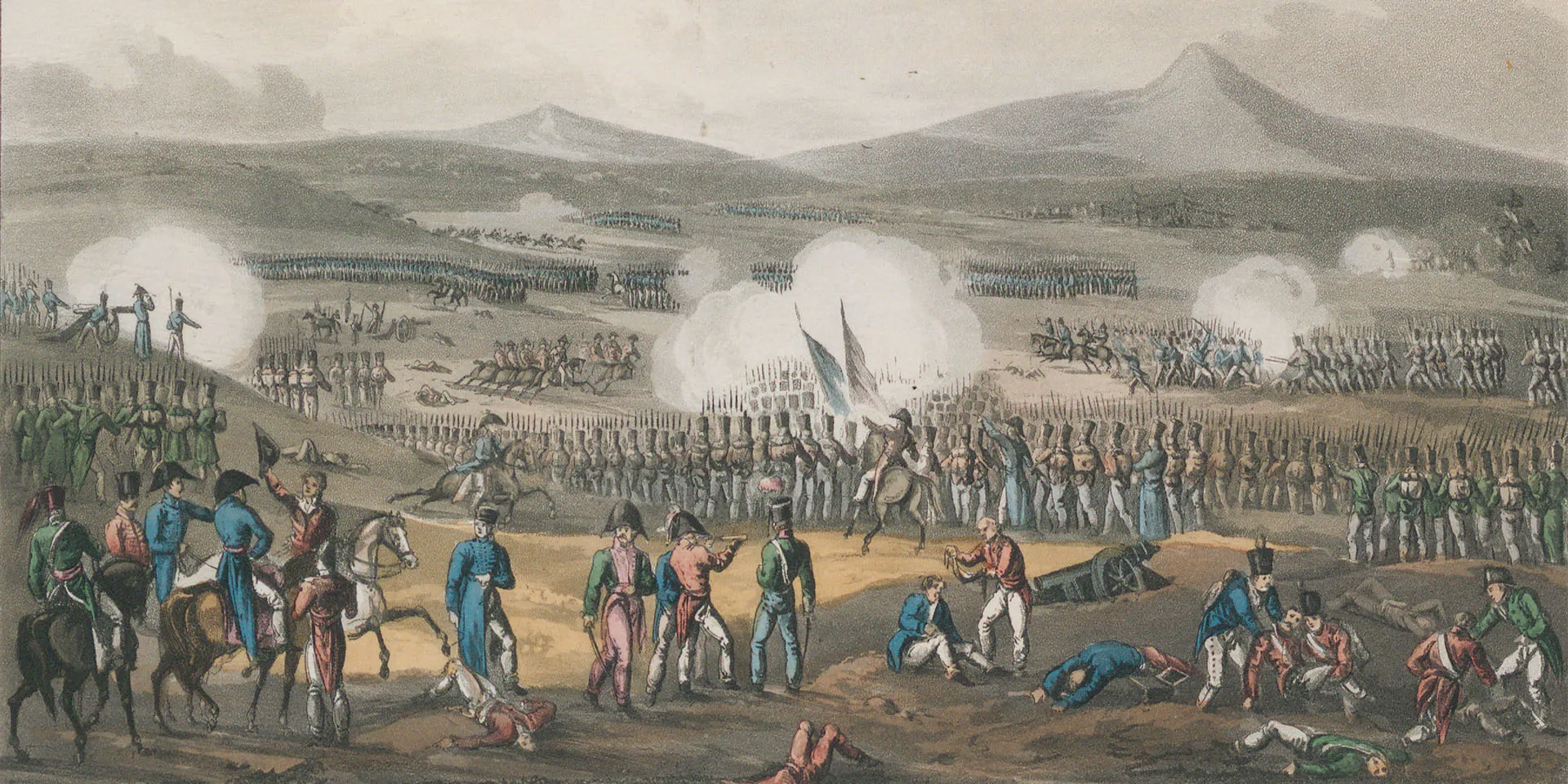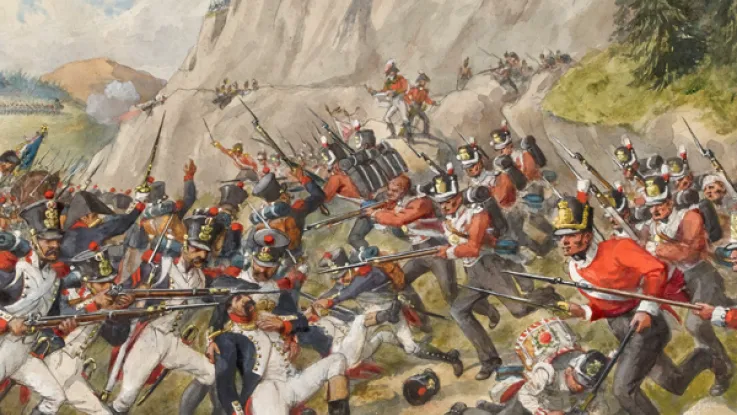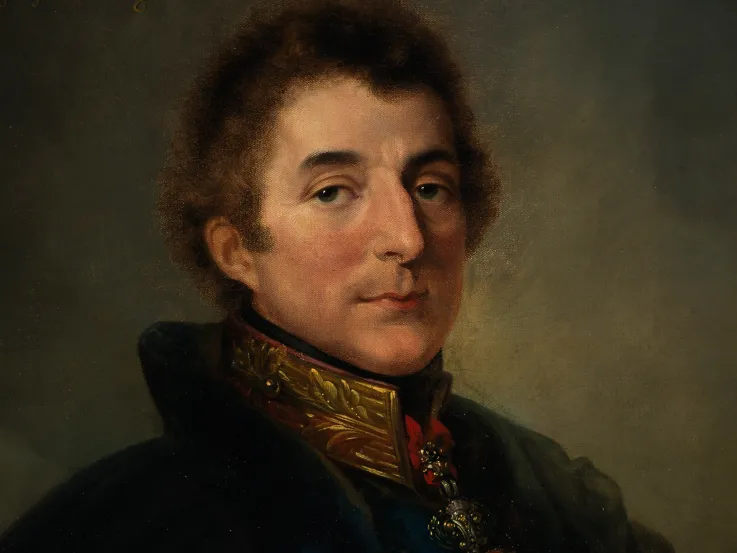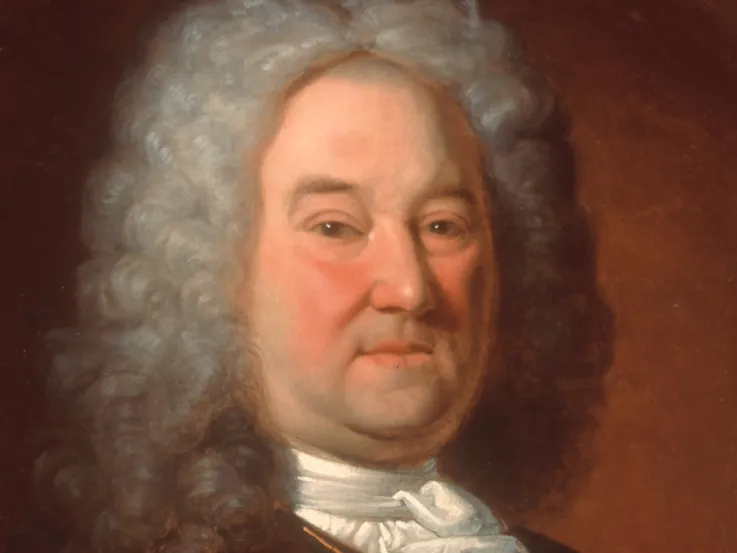A troubled childhood
John Alexander Dunlop Agnew Wallace was born around 1774-75, the son of Sir Thomas Dunlop Wallace of Craigie, Ayrshire, and his first wife, Eglantine Maxwell.
His mother was a fiery tempered writer and his father suffered financial problems, which eventually resulted in the sale of the family estate. Their marriage ended in a bitter legal separation in 1778.
India
In 1787, aged only 12 or 13, Wallace was commissioned into the 74th (Highland) Regiment of Foot, a unit newly raised for service in India. His first combat experience came during the Third Mysore War (1790-92) against the forces of Tipu Sultan, the ruler of the Kingdom of Mysore, who had long been a thorn in the side of British ambitions in southern India.
Wallace's service during this conflict included the siege of Seringapatam, Tipu’s capital, in 1792, where he served as aide-de-camp to Lieutenant Colonel Hamilton Maxwell. Victory there brought the war to an end. However, to guarantee the peace treaty, the British imposed the remarkable demand that Tipu hand over two of his sons as hostages.
Mediterranean
Wallace returned to England in 1796 and took command of a company of the 58th (Rutlandshire) Regiment of Foot. Britain was now engaged in a protracted and widespread war against Revolutionary France, which drew Wallace and his regiment into engagements at both ends of the Mediterranean.
In 1798, he took part in the capture of the strategically important island of Minorca from Spain, at that time one of France's allies. A few years later, he was deployed to Egypt, where his regiment was heavily engaged at the Battle of Alexandria (1801). This crucial British victory helped thwart French ambitions in the Middle East.
Peninsula
In 1805, by now a lieutenant colonel, Wallace took command of the newly formed 2nd Battalion of the 88th Regiment of Foot (Connaught Rangers). In 1809, he was despatched to the Iberian Peninsula, where the British and their Portuguese and Spanish allies were engaged in a struggle against the French.
The French had become embroiled in Iberia in an effort to cut Britain off from continental trade. Instead, the war here provided an opportunity for Britain to fight back.
While the French enjoyed numerical superiority for much of the Peninsular War (1808-14), they were unable to evict the stubborn British, who made repeated forays into the Spanish interior from their secure base around the Portuguese capital, Lisbon. Far from being a path to victory, this campaign placed a heavy strain on French resources and so became known as ‘the Spanish ulcer’.
‘The Connaught Footpads’
In September 1809, at Campo Mayor in Portugal, Wallace took charge of the Connaught Rangers’ 1st Battalion, which had taken heavy losses at the Battle of Talavera in July. This was to prove his most important command.
While the men of the Connaught Rangers were already known for their bravery, they had also acquired an unfortunate reputation for plunder and ill-discipline. This had resulted in their divisional commander, Major General Sir Thomas Picton, giving them the derogatory nickname ‘The Connaught Footpads’ (a footpad being a street robber or thief).
This was not a true reflection of their record of service and was entirely the result of anti-Irish prejudice. In any case, it did not serve to deter Wallace, who worked hard to improve the battalion’s fighting efficiency.
A talented officer, Wallace infused the unit with a new energy and discipline. He also instigated administrative reforms and a new training regime, which would help turn the Connaught Rangers into one of the finest regiments in the army of Lieutenant General Arthur Wellesley, Viscount Wellington (later the Duke of Wellington).
Busaco
Wallace’s efforts paid dividends when the Connaught Rangers distinguished themselves the following year at the Battle of Busaco. This was a defensive action, which saw the British holding a ridgeline against a superior French force.
While the British position was a strong one, the French had managed to crest the ridge and were threatening to break through. Facing this crisis, Wallace rallied his men with a speech in which he urged: ‘Press them on to the muzzle, I say, Connaught Rangers, press on the rascals.’ He then led them in a valiant counterattack, which recovered the situation and drove the French back in headlong retreat.
This bold action won the admiration of both Wellington and Picton, who commended Wallace for ‘that brilliant exploit’.
Fuentes de Oñoro
In May 1811, the British again found themselves fending off a powerful French attack, this time in a village along the Rio de Dos Casos. The French crossed the river and penetrated deep into the village of Fuentes de Oñoro, a feat which once more posed a threat to the British line.
The Connaught Rangers were assigned the task of leading the counterattack. With bayonets fixed, Wallace led his men in another gallant charge. They swiftly succeeded in clearing the village and driving the French back across the river.
‘Tell him [Wallace] to come down and drive these fellows back: he will do the thing properly.’Lieutenant General Arthur Wellesley, Viscount Wellington, issuing orders for the counterattack at Fuentes de Oñoro — 1811

The Battle of Fuentes de Oñoro, 5 May 1811
On the offensive
In 1812, the balance in Spain began to shift against the French. They were constantly harassed by Spanish guerrilla fighters and their resources were depleted by Napoleon’s disastrous campaign in Russia. This provided Wellington with the opportunity to go on the offensive.
His first targets were the fortified towns of Ciudad Rodrigo and Badajoz, both of which were besieged and then bloodily stormed. While Wallace was away, sick with fever, his regiment played a prominent role in both these daring assaults.
Salamanca
Wallace had returned to duty in time for the great clash at Salamanca on 22 July 1812, where he was now in command of a brigade. The Connaught Rangers formed part of his new formation and spearheaded an attack mounted by Major General Edward Pakenham’s Third Division, which shattered the exposed left wing of the French Army and so helped bring about a crushing British victory.
Lieutenant Colonel Henry Jourdain, the regimental historian, recorded how the decisive moment of the attack came when Major Barnaby Murphy, who was leading the Connaught Rangers on horseback, was shot dead. This alarming sight spurred the men to launch their final assault.
It was during this encounter that a Turkish crescent - taken by the French during their fighting in Egypt - was captured by the Connaught Rangers. Nicknamed the ‘Jingling Johnny’, this battle standard became their most prized war trophy.
‘Major Murphy was shot dead at this moment, and his body, with one foot caught in the stirrup-iron, was dragged along the front of the Connaught Rangers by his frightened horse. The sight caused the men to become greatly excited. Packenham immediately afterwards, seeing that the right moment was now at hand, called to Wallace “Let them Loose”. Instantly the three regiments surged forward and with the impact the French column quickly went to pieces.’Lieutenant Colonel Henry Jourdain recounting the assault by Wallace’s brigade at Salamanca — 1812
‘The Devil’s Own’
Salamanca was Wallace's last battle of the Peninsular War. He was again afflicted by fever and was seriously ill for eight months. However, the Connaught Rangers continued to meet the high standards that he had set them.
They played their full part in the series of battles that would drive the French from Spain and see them defeated in their homeland in 1814. By this time, the courage and ferocity of the men had earned the regiment the rather more flattering nickname of ‘The Devil’s Own’.
Regimental Medal
Wallace resumed command of the 1st Battalion in August 1815, while it was employed as part of the army occupying France following the final defeat of Napoleon.
In June 1818, he lobbied the War Office to have a special medal produced in recognition of the Connaught Rangers' service in the Peninsula. His request was granted later that month and Wallace arranged for the medals, in three classes, to be produced at the expense of the officers of the regiment.
‘Sir, I have the honour to state that some of the non-commissioned soldiers of the 88th Regiment have served in twelve different general actions, and have been two, three and four times wounded, have been a long time in the Regiment, and have always conducted themselves well in the field and in quarters. I am anxious to bestow upon them some mark of distinction for their good conduct, and an encouragement to them and others in future. ‘I shall be much obliged if you will obtain His Royal Highness the Commander-in-Chief’s permission for me to give such men medals as a testimony of their merit.’Letter from Wallace to the Adjutant General regarding a regimental medal for the Peninsular War veterans of the Connaught Rangers — June 1818

King’s Colour, 88th Foot (Connaught Rangers), 1808-20

Regimental Colour, 88th Foot (Connaught Rangers), 1808-20
Colonel of the Regiment
Wallace's strong bond with the Connaught Rangers was reasserted in 1820, when he received as a gift the colours carried by the regiment during the Peninsular War.
In 1831, he was appointed Colonel of the Regiment. By this time, he was a major general. He was also now married, to Janette Rodger. Together, they would have six children.
Wallace was later promoted to full general, made Knight Commander of the Bath (KCB) and became a baronet on the death of his father in 1836. He himself died at the age of 82 at Lochryan House, Stranraer, on 10 February 1857.















